Some time ago, while working on nineteenth-century literary markets, I was struck by how thoroughly British and French novels managed to streamline European cultural consumption: hundreds of thousands of people reading more or less the same books, and at the same time. This looked so much like the beginning of the culture industry that it suggested a little follow-up experiment—on film markets, this time. I began with the records published in Variety, and listed the 5 most successful American films for every year between 1986 and 1995; then I turned to non-American markets, in order to assess the extent of Hollywood’s planetary diffusion. Here, the sources (Variety International, Screen International, and various related yearbooks) turned out to be extremely patchy, and I decided to map only those countries for which at least two years were fully documented; this made the sample a little more reliable, but unfortunately much more unbalanced: of 46 countries with ‘enough’ data, 25 are in Europe; Africa is almost entirely absent, as are many Asian and Latin American countries, and the demographic giants of India, China and Russia.
Big blanks. Since, however, some interesting patterns emerge, I am writing these pages anyway. Take them for what they are: initial hypotheses that should be tested against a larger, more precise set of data.
I
Figure 1: the sheer power of Hollywood. In 24 countries (the black triangles), American films make up between 75 and 90 per cent of the decade’s top hits; in another 13 (the black stars) the percentage climbs above 90; in 5 cases it reaches 100. (While spending a year in Berlin, every now and then I checked the top ten hits of the week; always at least 9 American films, if not 10.) ‘When one talks of cinema’, wrote the Brazilian avant-garde director Glauber Rocha in the 1960s, ‘one talks of American cinema . . . Every discussion of cinema made outside Hollywood must begin with Hollywood’. Indeed.
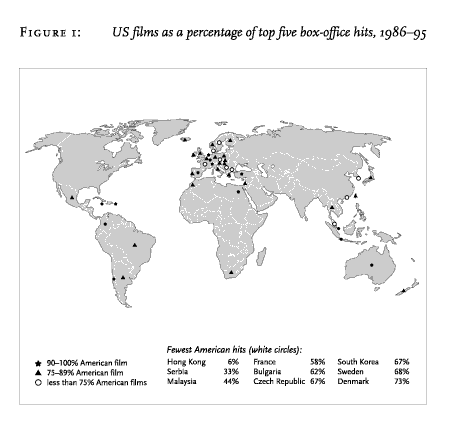
But first, a few words on those nations (the white circles) where Hollywood encounters an obstacle, and falls below 75 per cent of box-office hits. Sweden and Denmark are the core nations of Scandinavia: an area, as a dissertation by Leyvoy Joensen has shown, with a very strong regional identity, where not just Danish or Swedish novels, but Icelandic and Faroese ones had quite a criss-cross circulation. As for the Czech Republic, Serbia and Bulgaria, they are the tip of the—melting—East European iceberg: in the Czech Republic, American films accounted for less than 30 per cent of box-office hits before 1989; afterwards, they reached 76 per cent. And the same trend is visible in Slovakia and Poland (and Estonia, Romania, Slovenia: but their data were too erratic, so they don’t appear in the map).
Then, France. Where the story is different; Paris was the Hollywood of the nineteenth century, its novels were read and imitated everywhere—they even invented cinema there! No wonder they hate the other Hollywood, no one likes to give up symbolic hegemony; but no one keeps it by mere force of will either, and although France knows how to protect its own market (which was twice inundated by foreign films, in the 1920s and 1940s, and twice bounced back), there is no question of its competing with Hollywood abroad. Between 1986 and 1995, only four non-American films enjoyed a large international success: A Fish called Wanda, Four Weddings and a Funeral, Crocodile Dundee, The Last Emperor: two British comedies, an Australian comedy, an American–Italian melodrama. None of them was French. In fact, none was any different from the usual Hollywood fare . . .
II
Scandinavia, Eastern Europe, France: all ‘residual’ sub-systems, that don’t threaten Hollywood’s hegemony. The true rival is in Asia: Hong Kong. (As I already said, I could not find enough data for the other obvious candidate, India.) In the sample decade, only Jurassic Park and Speed made it into the Hong Kong list; all other hits were local products. And Hong Kong has also its regional sphere of influence: Malaysia, Taiwan, partly Thailand, probably Pakistan and Bangladesh and China (whose insufficient data don’t appear in the map).
Of course, the future of the Hong Kong film industry is not clear: it may be stunted by the incorporation into the People’s Republic of China—or the exact opposite: the larger market may be a boost to production and inventiveness. Be that as it may, in the last generation or so (from Bruce Lee to Jackie Chan and beyond) Hong Kong films have very efficiently caught the wake of Hollywood’s greatest export staple: the films of action and adventure charted in Figure 2.footnote1 With its many fuzzy internal divisions, but quite clear external borders, this is by far the most successful form both inside the US and abroad (with the exception of Europe, about which more later). South and East Asia are these films’ favourite destination: they account for 50 per cent of the decade’s hits in Singapore, 55 in South Korea, 65 in Indonesia, 67 in Taiwan and Thailand, 80 in Malaysia (and the sporadic data for Pakistan, India and Bangladesh confirm this pattern).
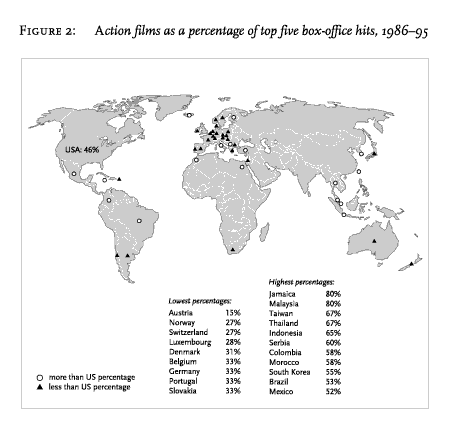
Behind this diffusion is at work one of the constants of cultural geography: stories travel well—better than other genres, anyway. It was true centuries ago, when Indian and Arab tales crossed the Mediterranean, and transformed European storytelling; it is true today, for these concatenations of striking events and hyperbolic actions (and tomorrow, with videogames: stories that never stand still, where the only thing that matters is what happens next . . .). And stories travel well because they are largely independent of language. Within a narrative text, style and plot constitute discrete layers, and the latter can usually be translated (literally: carried across) independently from the former. (A favourite example of narrative theorists used to be, ‘one can take a novel, and turn the plot into a ballet’: just what happens in so many Hong Kong films.) This relative autonomy of the story-line explains the ease with which action films dispense with words, replacing them with sheer noise (explosions, crashes, gunshots, screams . . .); while this brisk dismissal of language, in turn, facilitates their international diffusion. Significantly enough, in the 1920s American films were already enjoying a worldwide hegemony: what brought it to a halt was the invention of sound, which elevated language into a powerful barrier, supporting the quick take-off of the various national film industries. The abrogation of language in action films is a powerful factor in turning the tide around.
III
Next map: comedies (Figure 3). In the US, they account for 20 per cent of box-office hits; elsewhere they are usually much less successful—look at East Asia, the Mediterranean, or at the percentages indicated in the map. By contrast, even in those countries (the white circles) where Hollywood comedies are relatively more successful, the difference with the US is often insignificant.
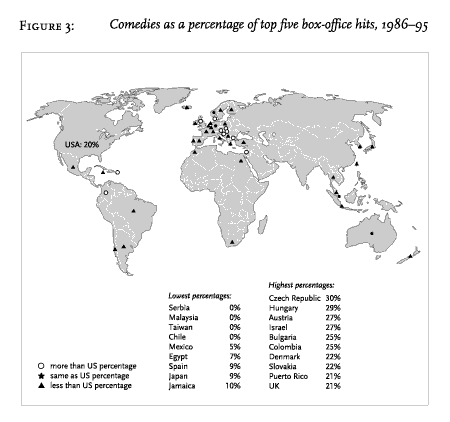
Another rule of cultural geography: relatively speaking, comedies do not travel well. Compared to other French genres, the enormously popular comic novel of early nineteenth-century France, the roman gai, had a rather modest European diffusion. In a neat reversal of what we just saw, the main reason for this inertia is almost certainly language: since jokes and many other ingredients of comedy rely heavily on short circuits between signifier and signified, they are weakened by translation—and indeed comic films reached the apex of their world diffusion long ago, before the age of sound. Just as significant as language, however, is the fact that laughter arises out of unspoken assumptions that are buried very deep in a culture’s history: and if these are not your assumptions, the automatic component so essential to laughter disappears. Which is interesting, we usually associate the national spirit with the sublime (et pour cause: unknown soldiers, torn flags, battlefields, martyrs . . .) yet, what makes a nation laugh turns out to be just as distinctive as what makes it cry. If not more distinctive, in fact: the same sublime objects reappear relentlessly from one culture to another, whereas the targets of comic aggression seem to be much more idiosyncratic, more variable. All sublime nations resemble each other, we could paraphrase Anna Karenina, but when they start laughing, they all do so in their own unique way.
The international weakness of Hollywood comedies, then, has much to do with their being American; or perhaps, better, with their being non-Brazilian, non-Finnish, etc. In many cases—Brazil, Argentina, Mexico, Sweden, Finland, Britain, Australia, Hong Kong—market records suggest a genuine passion for national comedies which becomes spectacular in Italy, where every single national hit of the sample decade was a comedy (as would be, a few years later, the biggest Italian success of all times, Life is Beautiful). This fixation—which began in the sixties, and apparently will never end—must have something to do with that mix of aggression and anxiety that psychoanalysis has recognized in laughter, and that is so typical of the emotional cosmos of the commedia all’italiana. It’s the grimace of a culture structurally unsure about its position in the world: the last of the ‘advanced’ countries, arrogantly showing its teeth to what is left of the past—or the first of the ‘backward’ ones, populistically bent on ‘decrowning’ those placed above it?
IV
Figure 4: children’s films. In the US, 25 per cent of box-office hits; in most other countries, much less—at times almost nothing (and I will come to that in a moment). But the American results are arresting in themselves. One in every four box-office hits aimed at children? This seemed so odd that I checked the statistics for the years of my own childhood, and in the pages of Variety for 1955 and 56 and 57 I found what I remembered so well: there were so few children’s films then! A cartoon in the top ten around Christmas—for a couple of weeks, in a couple of places; period. (I say a couple of places because, then, the American market was still so uneven that the top ten changed a lot from town to town; today, the very idea seems quaint.) In the mid-fifties, not a single film for children made Variety’s top twenty for the year, with the only possible exceptions of 20,000 Leagues Under the Sea and Around the World in 80 Days: both children’s films in a very dubious sense (and both drawn from nineteenth-century French novels, by the way).
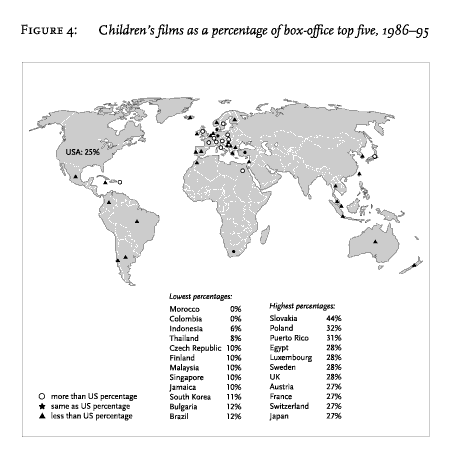
Today, the top twenty routinely includes four or five children’s films, and the reason, I suspect, is quite simple: money. These films are more successful because much more money is spent on children’s entertainment. But this extra income is not available everywhere, and the result is the skewed distribution of Figure 4, where the (relative) absence of the genre tends to overlap with the poverty of each given country. The correlation is not perfect, they never are (look at the data for Egypt, or Puerto Rico, or Singapore), but it seems real enough, and, incidentally, it also works inside the United States: studying New York videostores, my students and I discovered that the presence of children’s films in Harlem and the Bronx ranged between 3 and 8 per cent; in the Upper West Side and Upper East Side, between 10 and 19 per cent. Three times higher.
‘Children’s films’ is a sloppy definition, of course: it points to the audience, not the film—and to an audience which is moreover quite problematic. Children, after all, don’t usually go to the movies by themselves and, as adults must take them, a little generic paradox ensues: whom should the film be for—the adult, or the child? Faced with this problem, the fifties offered either straightforward fairy tales (for the child: Cinderella, Snow White, even Fantasia), or those Jules Verne novels I mentioned earlier (which were much more successful than the fairy tales: another sign of a market directed at the adult). But today the two forms have converged, blending into a hybrid which appeals to children and adults alike: E. T., Roger Rabbit, Back to the Future, the various Star Wars and Indiana Jones—these are stories designed for a new human species of savvy children and silly grown-ups (Homo puerilis). Their god is Steven Spielberg (and Benigni is his prophet: Life is Beautiful—what a childish adult wants a child to know about Auschwitz).
In one film after another (Jaws, Close Encounters, Indiana Jones and the Temple of Doom, Jurassic Park; even the uncanny detail of the girl in red, in Schindler’s List), Spielberg has not only chosen stories in which children and adults are somehow involved together, but where the ambiguities so typical of (adult) life are defused by the (child’s) desire for polarization so well described by Bruno Bettelheim. The best example is Schindler himself; this Third Reich shark turned benefactor, who offered an incredible chance to study the contradictions of historical existence. But Spielberg is not interested in understanding complicated things, and in his hands this figure out of Dostoevsky, or Brecht becomes—nothing.
V
So. The diffusion of American comedies is low almost everywhere, children’s films tend to prefer wealthy areas, action films South and East Asia . . . Each genre has its favourite space, its different diffusion pattern, and it’s precisely this difference that makes cultural geography useful (if all films were evenly distributed everywhere, these maps would be pointless: maps need unevenness, they signify through unevenness). And the unevenness is there because each region of the world functions like a cultural ecosystem: it tends to select one genre—and to reject another. It selects one genre because it rejects the other: setting side by side the maps of children’s and action films, a striking coincidence emerges between the strength of the latter and the weakness of the former: Colombia, Jamaica, Morocco, Thailand, Malaysia, Indonesia and South Korea are all present in the tables charting the ten countries with most action films and fewest children’s films. Same message from Figure 5, which charts the ten countries with fewest action films and most dramas: seven European countries (Portugal, Spain, Switzerland, Austria, Belgium, Luxembourg and Norway) are present in both lists—while five of the remaining six countries are also in Europe.footnote2
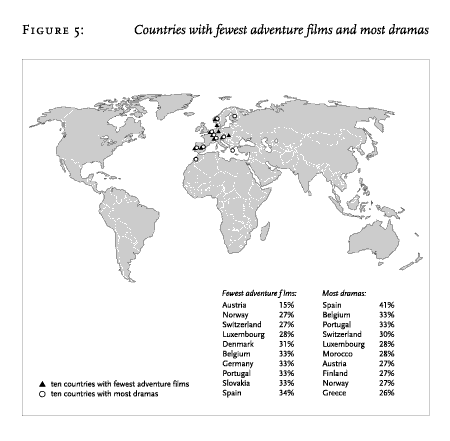
We see here the Darwinian side of cultural geography: forms that fight for space. They fight for the limited resources of the market, and if one manages to successfully occupy one space, other forms will encounter all sorts of obstacles. In trying to explain large geographical patterns, then, the isolated case is seldom enough: the strength (or weakness) of one form can only be explained by looking at the whole system of variables at play. And with this, I turn to my last point.
VI
The nineteenth century saw a European diffusion of Anglo-French novels; the twentieth century, a planetary diffusion of American film. And the reactions to this centralized global market? Every discussion of cinema made outside Hollywood must begin with Hollywood, said Glauber Rocha. Must it also end with Hollywood?
Here, the history of the novel offers an interesting precedent. In his work on Brazilian novels, Roberto Schwarz has shown that the power of metropolitan models has a twofold effect on cultures of the periphery. First of all, it generates a ‘disagreement between the form [which is foreign] and the material [which is local]’: ‘nothing is more Brazilian than these half-baked novels’, he goes on, so full of ‘dissonance’ and ‘compositional defects’. ‘An impossible programme’, says Masao Miyoshi of the modern Japanese novel; and similar things have been independently said just about everywhere.footnote3 In the case of less powerful literatures, then—which means: almost all literatures, inside and outside Europe—the import of foreign novels doesn’t just mean that people read a lot of foreign books; it also means that local writers become uncertain of how to write their own novels. Market forces shape consumption and production too: they exert a pressure on the very form of the novel, giving rise to a genuine morphology of underdevelopment.
But this is not the whole story. Every now and then, one of those ‘impossible programmes’ works. Machado de Assis takes the ‘compositional defects’ of Brazilian novels, and turns them into an incredibly original narrative style. Elsewhere, the clash with the symbolic power of Western Europe produces major paradigm shifts, like the Russian novels of ideas, or Latin American magical realism (or the slightly different case of the Kafka–Joyce generation). Although these remain exceptions, they occur often enough to show a counter-force at work within the world literary system. The morphology of underdevelopment is not without its surprises.
And in film? Here, reversing the tide is probably more difficult, given the stronger economic constraints (production costs, distribution monopolies, dumping practices . . .), but hardly impossible. A critical reconstruction of the history of film, and of its present, will eventually offer an answer. From the viewpoint of method, however, the crucial point is the one made by Christopher Prendergast in his review of Pascale Casanova’s République mondiale des lettres: when trying to understand the world system of culture, ‘a single, generalizing description misses too much and is destined to do so, if it is offered as the description’.footnote4 This, of course, is just as true for the quantitative evidence I have used as for the study of individual directors, or film genres: the solution lies in multiple layers of description and explanation, linked together by a chain of successfully analysed ‘details’ (Prendergast again). God lies in the detail—perhaps. Our understanding of culture certainly does.